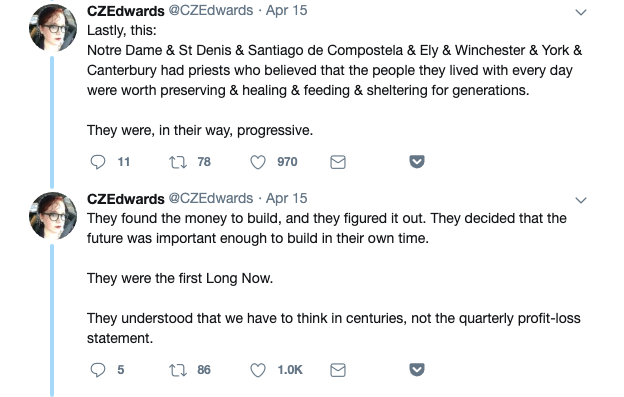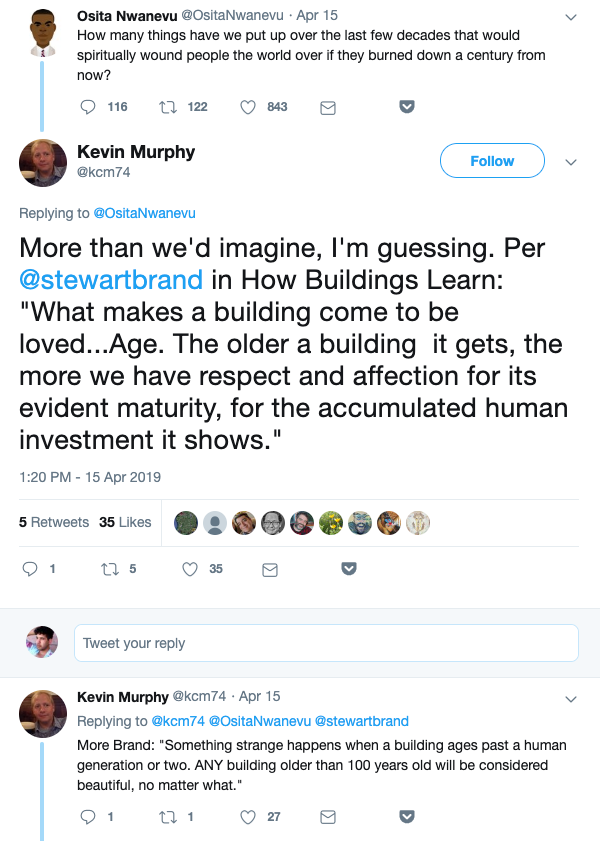In the hours after news broke that the Cathedral of Notre Dame suffered extensive fire damage, many found hope in a story that circulated on social media about a centuries-old protocol the fire department in Paris followed when battling the fire. The story originated with Twitter user Michael Slavitch, who claimed that firefighters prioritized saving the people and relics over preserving the wooden roof structure of Notre Dame because they knew that the materials needed to rebuild it lay waiting in the Palace of Versailles. After the French Revolution, when large parts of the cathedral were desecrated and damaged, oak trees from Versailles were used to rebuild it. The oaks that were planted thereafter were intended to be used to help rebuild Notre Dame, should it become necessary in the future.
“This is the Long Now in action,” Slavitch tweeted. “It’s what happens when you maintain civilization.”
For many, Slavitch’s story was a silver lining on a dark day. But it is almost certainly apocryphal.¹ It also bears striking similarity to another apocryphal tale we like to tell at Long Now about the oak beams at Oxford.
Stewart Brand on the oak beams of New College, Oxford in “How Buildings Learn.”
That so many wanted the story of the Versailles oaks to be true testifies to the power of foresight and long-term thinking. Just because these stories are apocryphal does not mean they aren’t instructive in teaching us to think long-term. (The Oxford oak beams story, after all, helped inspire the founding of The Long Now Foundation.) Slavitch may be off the mark when he says there are oaks at the ready to rebuild Notre Dame, but he’s correct when he says that doing so is a way to maintain civilization.
In the aftermath of the fire, a number of Long Now community members offered perspective and reasons for hope. Others helped contextualize the fire by invoking some of Long Now’s ideas about long-term thinking. Some of those responses and quotes are reproduced below.
From Jeffrey McGrew, architect of The Interval at Long Now, who spoke there in 2015:
Thankfully I believe the entire structure was laser-scanned inside and out at an extremely high level of detail just a few years ago by a a group of art historians and academics.
Also with the rise of more affordable large-scale digital fabrication, which is behind the incredible progress made at La Sagrada Familia in recent years (turning what was going take a few more generations into something that will be completed within our lifetimes), it’s possible the reconstruction could take much less time than anticipated.
A terribly sad day indeed, but also there is hope for the future.
From writer CZEdwards:

From historian Kevin Murphy, quoting “How Buildings Learn” by Long Now Co-Founder Stewart Brand:

From Paul Saffo, a futurist at Stanford and Long Now Board Member:
Watching the news, I cannot shake the feeling that profound and unexpected good will rise from the Notre Dame fire.
In a century, the fire may well be remembered as the event that saved this cultural treasure — and other treasures.
And the fire will remind the rest of the world to love it. The fire will shock the keepers of other cultural treasures worldwide and cause them to look closely at additional protection/preservations. Other treasures will thus be saved from neglect.
For the French, Notre Dame is a national cultural symbol as well as a religious symbol. Its restoration can become a magnet to inspire and bring the public together and help rekindle French solidarity in this perilous and uncertain time. And the restoration is an invitation to to rebuild for another 1000 years.
I couldn’t help but think of the motto of Paris, Fluctuat nec mergitur [“this vessel rocks but is never submerged”]. A motto, incidentally, that speaks to us all amidst the stormy global sea today. Wave-tossed but still afloat… indeed…
Noting the construction of Gaudi’s Sagrada Familia in Barcelona, the restoration project could be an opportunity for dramatic architectural/engineering innovations that honor the past and lead the future.
All in all, it is a reminder that Notre Dame is neither a museum nor a mere historical artifact, but a living, breathing structure, the heritage not only of the French, but all mankind.
Footnotes
[1] When a Twitter user questioned the provenance of Slavitch’s account, he said he heard it at a lecture in Versailles on disaster recovery and long-term planning over a decade ago. But no one thus far has succeeded in verifying Slavitch’s claims about the protocol and the oaks of Versailles. The day after the fire, the Associated Press reported that a French cultural heritage expert said France no longer has trees big enough to replace the Notre Dame’s wooden beams. The expert made no mention of the oaks of Versailles. A Reddit user said they asked the Versailles press office if the story was accurate. The press office supposedly issued a denial in response: “La rumeur qui circule sur les réseaux sociaux est fausse. Elle est sans fondement historique, compte tenu du caractère royal du domaine.” (Roughly: “The rumor circulating on social networks is wrong. It has no historical basis, given the royal nature of the estate.”) The Palace of Versailles press office has yet to respond to a Long Now inquiry of this writing.